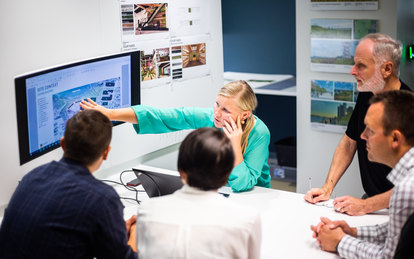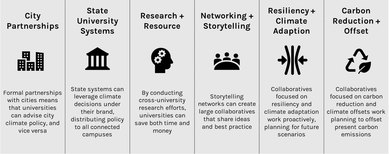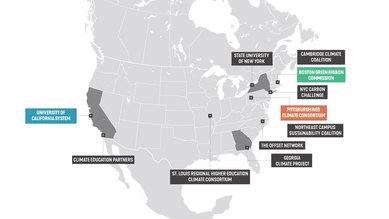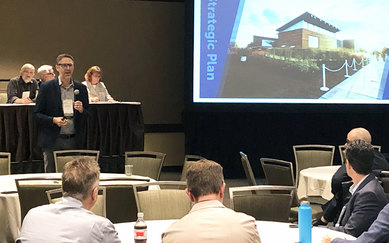Every College and University Should be Part of a Climate Collaborative

The scale of change needed to address the climate crisis can be daunting. The Intergovernmental Panel on Climate Change (IPCC), reports that the U.S. is far from meeting the targets needed to avoid the disastrous impacts of climate change[i]. Therefore, it is becoming increasingly urgent for stakeholders to identify how to “be part of the solution.” Building-by-building approaches and individual urban actors, though beneficial, will not achieve the dramatic results we need. Instead, action on a large scale and collaborations led by our most influential institutions are necessary to find system-level approaches that go beyond institutional boundaries to address issues and give us a chance to meet and exceed our climate goals.
Colleges and universities have long been recognized as the drivers of scientific research, economic development and social innovation in the cities and towns they call home. Thus far, most have viewed climate action as a cooperative endeavor, such as the Green School Listserv hosted by Brown University, which has provided an online forum for campus sustainability topics since 1992. Although there is some competition among campuses to be the first to achieve various sustainability ratings and rankings attractive to students and faculty, the general tone is, “let’s share our best ideas.”
Higher education institutions today are uniquely well-positioned to become leaders of the necessary movement. A rising number are taking up the charge to find solutions, create policy and make meaningful change that goes beyond their walls to influence their communities and regions.
From Pittsburgh to Paris, academic institutions are creating collaborative models to address the expanding issues associated with mitigating greenhouse emissions, adapting to future weather shocks and other stressors related to climate change. By partnering with peer or co-located institutional partners or even municipalities, collaboratives can more rapidly advance climate-related initiatives through resource-sharing, research coordination, greater political leveraging and stronger messaging. By breaking down boundaries between institutions and cities, collaboratives offer opportunities to find innovative solutions at the systems level, such as district energy solutions, green infrastructure and bike/pedestrian mobility strategies. Collaboratives can speed development and implementation of solutions by leveraging political influence and using campuses as living laboratories to test and refine feasible solutions. Working together, they can effectively spur the change that we, and the planet, need.
One such collaborative, the Higher Ed Climate Consortium (HECC) in Pittsburgh is an effective model that has shifted its members towards a deeper sense of urgency. HECC brings together 11 institutions and the City of Pittsburgh to accelerate the City’s climate and resiliency planning efforts. Since 2017, I have advised the City and the institutions that comprise HECC, my local climate collaborative, by sharing my experience guiding climate action planning for cities as well as universities, and encouraging a greater level of participation and cross-collaboration among its members.
The City of Pittsburgh and the higher education institutions that call it home share people, infrastructure, research, goals, and more. Since 2008, HECC has played a critical role in not just bringing us together, but also putting intentionality behind advancing campus goals individually and collectively to take advantage of the city-wide scale and opportunity.
Dr. Aurora Sharrard
Director of Sustainability, University of Pittsburgh
Although HECC has made progress in fostering an ongoing dialogue about sustainability between member universities and the City of Pittsburgh, we realized that creating significant change will require broader alliances. In seeking to connect with and learn from other similar collaboratives, we presented our HECC model at the keynote panel at the Society for College and University Planning (SCUP) Mid-Atlantic conference held in Pittsburgh in 2018. At this year’s national SCUP conference, we teamed with representatives from two other collaboratives, the Boston Green Ribbon Commission and the University of California system’s collaborative to explore the organization and impact of various climate collaborative models.
An abbreviated presentation, focusing on the variety of collaborative climate models is available here.

There are a variety of existing models of higher education climate collaboratives.
Each collaborative discussed their structure and how they are helping their member institutions meet individual sustainability goals as well as advance city, state and regional goals associated with climate and resiliency. Though each collaborative is scaled differently and faces unique challenges, all relayed they are thinking beyond their campus boundaries and traditional approaches to address climate change. Since all the collaboratives are relatively new, much of our focus was on sharing best practices for building momentum and increasing influence.

Locations of higher education climate collaboratives in the United States.
The panel was well-attended, indicating a high level of interest from institutions across the country to convene their own climate collaboratives. Some key considerations about furthering the collaborative model that panelists agreed upon were:
- There is no single correct model for a higher education collaborative. Each campus and university system is unique. A multiple campus system that has have existing communication structures in place could benefit from an overlay of climate and resilience planning, while a smaller independent liberal arts college may find it beneficial to partner with regional or statewide collaboratives.
- National and international advocacy organizations are important to connecting universities, setting goals and fostering knowledge exchange. Two national entities that convene university sustainability leaders are the Association for the Advancement of Sustainability in Higher Education (AASHE) and Second Nature.
- Seeking connection with cities and regions is essential to both increasing the speed and scope of changes that will positively influence our environment. Therefore, local or regional collaborative models are becoming more critical to advance change at the citywide and regional scale.
- University collaboratives must develop actionable strategies. Real-world outcomes will encourage the level of engagement required to realize significant results.
While higher education collaboratives focused on climate change are a relatively new development, they hold great promise. These early stages are an exciting time full of interest in sharing knowledge and forming partnerships, and the most important next steps are teaming, listening and speaking on the topic to build momentum for this critical effort. As existing collaboratives mature, new partnerships are formed, and action begins to build, we must all work to answer the following questions:
- How do we grow the movement and increase the network of collaboratives?
- How can we improve existing models while focusing on action?
- How do we address equity, diversity, inclusion and justice in the climate conversation?
With additional resources and university-wide commitments, I am convinced collaboratives will be able to coordinate planning efforts, deliver climate and resilience research, and encourage policy change that will make positive lasting impacts on our environment.
